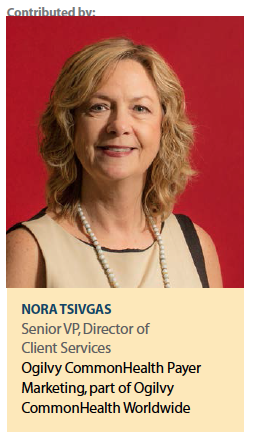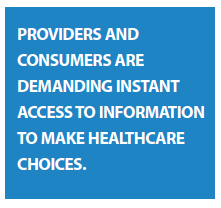 When it comes to healthcare communications, there is, literally, a “New World Order." Healthcare providers and consumers are accessing information via smartphones, tablets, laptops and even TVs. Calling or visiting an information source, such as a doctor’s office or local Medicare office, are the last options for obtaining needed information. Instant access is the new norm. Customer-centric focus from online communicators like Amazon and Zappos have raised the bar far beyond the typical pharma branded website, loaded with uni-directional pieces of information. Did you know that fully one in every 20 Google searches is for information about healthcare? Providers and consumers are demanding instant access to information that can help them make healthcare choices. Let’s take a look at why.
When it comes to healthcare communications, there is, literally, a “New World Order." Healthcare providers and consumers are accessing information via smartphones, tablets, laptops and even TVs. Calling or visiting an information source, such as a doctor’s office or local Medicare office, are the last options for obtaining needed information. Instant access is the new norm. Customer-centric focus from online communicators like Amazon and Zappos have raised the bar far beyond the typical pharma branded website, loaded with uni-directional pieces of information. Did you know that fully one in every 20 Google searches is for information about healthcare? Providers and consumers are demanding instant access to information that can help them make healthcare choices. Let’s take a look at why.
A Transformational Shift in Provider and Consumer Behaviors
A sea change in our healthcare delivery system, particularly in the United States, but globally as well, is driving a transformational shift in provider and consumer behaviors.
1. All former paper-based systems of collecting, retaining and accessing information are being digitized. Medical offices rely on electronic health records (EHRs) for scheduling, billing and maintaining comprehensive and accurate patient medical records.
2. The federal government, self-insured employers and large health plans are so strongly aligned with the Triple Aim goals that they are incentivizing the achievement of the Triple Aim goals: improvements in quality, reductions in high-cost care such as hospital readmissions and “never events," and engaging patients more effectively in care.
3. ACOs (Accountable Care Organizations) are leveraging these reforms by becoming much more patient-centric. ACOs are held accountable for specific patient engagement metrics like: timeliness of care, patient satisfaction, health promotion and education, and shared decision making.
4. Payment models are focused on value. This focus on value will spill over to affect pharmaceutical manufacturers in a big way as well. Historically, health purchasers have focused primarily on cost because quality has been so difficult to measure. Now that health information is being captured digitally, assessment of quality is much easier. Therefore, the ability to determine value by measuring quality against cost is more of a reality than ever before.
5. Consumers, however, do not yet have access to the treasure trove of quality metrics available in these data. As such, they are still making most healthcare decisions based on cost alone.
Riding the Digital CRM Wave
 Healthcare has gone digital, and organized pharma customers like health plans and health systems aim to purchase value, but healthcare consumers — patients — still have limited information and so continue to base healthcare decisions largely on cost. What’s a pharmaceutical manufacturer to do? The role of pharma manufacturers in this new world order often feels like that of victim. However, we would argue that there is a world of opportunity knocking on our doors. Pharma companies need to leverage digital CRM strategies to ride this wave of change.
Healthcare has gone digital, and organized pharma customers like health plans and health systems aim to purchase value, but healthcare consumers — patients — still have limited information and so continue to base healthcare decisions largely on cost. What’s a pharmaceutical manufacturer to do? The role of pharma manufacturers in this new world order often feels like that of victim. However, we would argue that there is a world of opportunity knocking on our doors. Pharma companies need to leverage digital CRM strategies to ride this wave of change.
Opportunities abound — here are a few to consider:
1. Leverage EHRs to drive patient education, shared decision-making models, patient engagement in CRM programs supporting adherence, access support, and cost savings.
2. Leverage data collection opportunities through digital CRM and other engagements like HUB services to obtain and assess information that will tell the value story of your product.
3. Educate consumers about insurance reforms such as the mandatory 100% coverage for 40 preventative health services like annual physicals and many screenings like mammograms and colonoscopy. These services are opportunities for early diagnosis and interactions with healthcare providers that could lead to treatment with your products.
4. Educate consumers about the real world evidence that your product delivers.
And the ultimate holy grail, made possible by technology — and made mandatory by the ever-increasing level of customer-centricity we experience every day now with Amazon, Peapod, and yes, most hospital systems — is to develop interactive relationships with the people who prescribe, purchase and take your products so that access, affordability, adherence, and the perception of value do not become the oh so common and persistent barriers that prevent them from giving and receiving the excellent outcomes promised in your clinical trials and marketing messages. (PV)
Ogilvy CommonHealth Worldwide — the health behavior specialists of Ogilvy &
Mather — is committed to creativity and effectiveness in healthcare communications, everywhere.
For more information, visit ogilvychww.com










